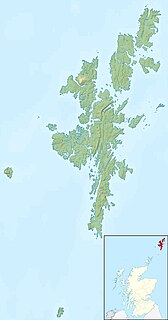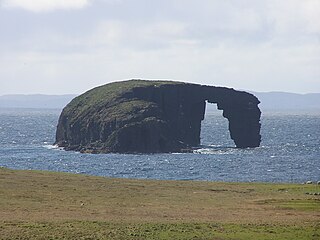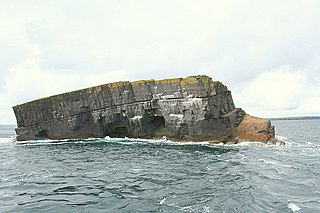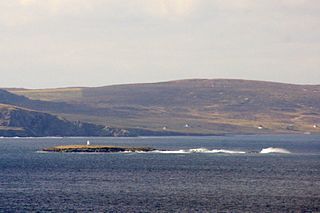
Orkney, also known as the Orkney Islands, is an archipelago in the Northern Isles of Scotland, situated off the north coast of the island of Great Britain. Orkney is 10 miles (16 km) north of the coast of Caithness and has about 70 islands, of which 20 are inhabited. The largest island, Mainland, is often referred to as "the Mainland", and has an area of 523 square kilometres (202 sq mi), making it the sixth-largest Scottish island and the tenth-largest island in the British Isles. Orkney’s largest settlement, and also its administrative centre, is Kirkwall.

Yell is one of the North Isles of Shetland, Scotland. In the 2011 census it had a usually resident population of 966. It is the second largest island in Shetland after the Mainland with an area of 82 square miles (212 km2), and is the third most populous in the archipelago, after the Mainland and Whalsay.

His Majesty's Yacht Iolaire was an Admiralty yacht that sank with great loss of life at the entrance to Stornoway harbour on the Isle of Lewis on 1 January 1919. The sinking of the yacht, which was originally the Amalthaea but renamed in 1918, was one of the worst maritime disasters in United Kingdom waters during the 20th century. Although the Iolaire struck rocks just yards from shore, at least 201 men out of the 283 people on board perished — most of whom were Royal Navy Reservists returning home at the end of the First World War — because of the appalling weather and sea conditions.

Mossbank is a village in the north east of the Mainland of Shetland, Scotland. Originally served by an inter island ferry steamer from Lerwick, this ceased when the Yell Sound ferry commenced from the small port of Toft, approximately 1 mile further north. The village was profoundly changed in the early 1980s when construction began on the nearby Sullom Voe oil terminal. Large amounts of temporary accommodation were erected to house the construction workforce, with the population expanding from 130 in the early 1970s to about a thousand a decade later. The number of residents staying in Mossbank is forever changing, making it hard to record a village population.

The Dore Holm is a small uninhabited islet off the south coast of Esha Ness, located in the north-west of Mainland, Shetland, Scotland. Its natural arch can be seen from the coast between Tangwick and Stenness. The shape of the arch has been compared to a horse drinking deeply from the water.

The Horse of Copinsay, also known as the Horse, is a rectangular uninhabited sea stack to the north east of Copinsay in the Orkney Islands, Scotland.

Gloup Holm is an islet in the Shetland Islands, lying to the north of Yell.

Yell Sound is the strait running between Yell and Mainland, Shetland, Scotland. It is the boundary between the Mainland and the North Isles and it contains many small islands. Sullom Voe, on the shores of which is a substantial oil terminal, is an arm of Yell Sound.

Linga is one of the Shetland Islands, in Yell Sound.

Little Holm is a small island in Yell Sound, in Shetland, Scotland. It lies between Northmavine and the island of Yell.

For other islands with similar names, see Gruney (disambiguation)
There are numerous islands containing the word holm, mainly in northern Europe. In many cases the name is derived from the Old Norse holmr, meaning "a small and rounded islet". These include:

The Gloup is a collapsed sea cave in the Mull Head Nature Reserve in the islands of Orkney, Scotland.

St Magnus Bay is a large coastal feature in the north-west of Mainland Shetland, Scotland. Roughly circular in shape with a diameter of about 19 kilometres (12 mi), it is open to the North Atlantic Ocean to the west. The indented coastline to the north, south and east between Esha Ness in the north and the Ness of Melby in the south contains numerous bays, firths and voes and there are several islands around the perimeter. The waters of the bay are up to 165 metres (541 ft) deep and may have been the site of a substantial meteor impact.
May Moar or Marjory Moar born May Hectorson was a British crofter in the Shetland Isles who was awarded an RNLI silver medal for rescuing fishermen off the island of Yell.















